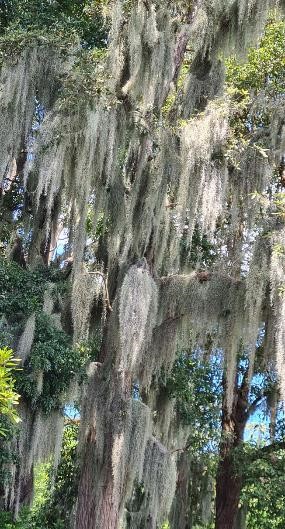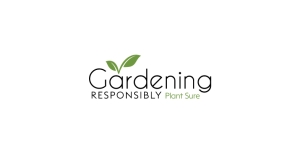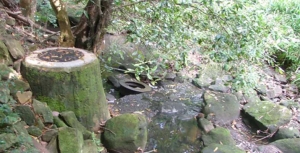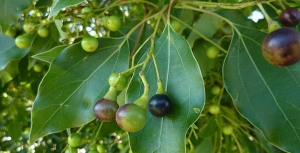Displaying items by tag: weeds
Recommendations
Spanish moss
Recommendations
Individuals
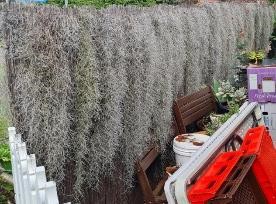
Remove all reachable festoons in your garden and put them into the green bin.
Control all festoons in garden trees by other means, e.g. spraying when safe effective methods have been established.
Do not give Spanish moss to friends, neighbours, passers-by and the local community.
Join campaigns to alert the local community and authorities to the threat posed by Spanish moss to bushland and gardens.
Authorities
Control authorities, e.g. state government, local councils, local land services and National Parks and Wildlife Service to urgently remove and control Spanish moss.
Educate the community about the threat posed by Spanish moss to bushland.
The Threatened Species Scientific Committee needs to add Spanish moss as a specific threat to the Critically Endangered Sydney Turpentine-Ironbark Forest.
Regulatory
Spanish moss must be added to:
- the next iteration of the Greater Sydney Regional Strategic Weed Management Plan and all other relevant regional strategic weed management plans
- these plans at a classification level that enables its eradication and containment, prohibition of sale and distribution, e.g. as a regional priority weed
Research
Immediate research is needed into:
- why Spanish moss flourishes on Turpentine, Brush Box and other rainforest species but not on most eucalypts
- the ecological consequences of infestation on individual trees and native plant communities
- the rate of growth and variation of growth with weather
- safe effective control options in Australian conditions
- fire ecology
Education
Education about the threat posed by Spanish moss to bushland through:
- TAFE NSW and private vocational providers – Spanish moss must be included on weed lists for horticultural, landscape, conservation and ecosystem management courses
- community groups – conservation groups (many are members of the Nature Conservation Council), gardening clubs (many are members of Gardening Clubs of Australia), Landcare, Greening Australia
- professional organisations – Australian Association of Bush Regenerators, The Society for Ecological Restoration Australasia, Ecological Society of Australia, Australian Institute of Horticulture
- gardening media – TV gardening and home improvement programs such as Gardening Australia, radio programs, magazines such as ABC Gardening Australia Magazine, Landscape Architecture Australia, Australian House & Garden
- social media – Facebook groups such as NSW Introduced Plant Identification and Bush Revegetation and Regeneration
Findings
Spanish moss
Findings
Spanish moss can grow almost anywhere, but during our survey it was obvious it flourished on some tree species and not others. Our observations indicate that the leachate from the host, or epiphytic species such as lichens and fungi, may be a determining factor for Spanish moss success. Spanish moss was recorded on trees from 32 plant families and 65% of records were from the Myrtaceae (Myrtle) family where turpentine and brush box dominated recordings. Of all the eucalyptus in the northern suburbs only one, red mahogany, was recorded repeatedly carrying substantial amounts of Spanish moss.
Festoons commonly occurred in the middle layer of the support plants (60%) and almost 90% were out of easy reach. Branches were the most common support (56%) followed by leaves, but only 12 host species (26%) were involved, primarily turpentines. Festoons were mostly 0.5 to 2 m long but some extended over 3 m. Sparse infestations were the norm (48%) but most individual festoons were dense.
Dispersal rate appears to have been slow with people and animals the main dispersal agents over long distances, but many observations indicate that the spread, density and size of festoons is increasing exponentially. It is no longer a sleeper weed.
Macquarie Uni initiative to reduce risk of invasive garden escapees
There are nearly 20,000 introduced plant species in Australia – roughly the same number as our native species – and while some were brought in for horticultural purposes, the vast majority were introduced as ornamental garden plants. Some of these have become problem invaders.
One such plant is lantana that was introduced as an ornamental species in the mid-1800s and has since spread across 4 million hectares. Birds spread its seeds, helping lantana invade native forests from their disturbed edges and forming dense thickets that dominate ecosystems. It costs graziers more than $100 million pa in lost production.
Another serious problem is privet, originally from Asia, which was enthusiastically adopted by the English as a hedging plant. It is too cold for them to fruit in the UK. They produce masses of fruit here that are widely dispersed into native bushland across the east coast by birds.
Thousands of seemingly harmless species we currently buy from nurseries, chain stores and markets, could also damage nearby ecosystems if they escape our gardens.
Garden Responsibly
Macquarie University’s School of Natural Sciences has recently launched another initiative in their program for Smart Green Cities. The program is called Garden Responsibly. The full website will be launched in September 2022.
The team that developed the website is led by Distinguished Professor, Michelle Leishman, a former president of STEP.
The data underlying the program comes from the Plant Sure scheme, a collaborative project between the Nursery and Gardening Industry Association of NSW and ACT, the Australian Institute of Horticulture and the NSW government. The scheme is designed primarily for use by industry specialists and checks international species databases to flag plants known to be invasive in other countries.
Plant Sure will help gardeners and plant sellers choose ornamental garden plants that will reduce the risk of future weed invasions. Gardening businesses that are certified under the Plant Sure scheme will receive stickers to identify and promote plants as 'gardening responsibly' participants.
Smart Green Cities
The Smart Green Cities program is a collaborative hub connecting industry, government, researchers and community to create liveable urban environments by inspiring change through evidence-based problem solving.
There are now many projects being undertaken investigating ways of making our cities more liveable in the face of climate change.
Weeds in national parks along sewer lines, energy transmission lines
My concern is that weeds occur along all land that has been disturbed in otherwise pristine bushland areas. These are unsightly and continually invasive.
For example, the sewer lines constructed through Sydney in the 1950s and 60s have much unfinished business in bushland areas where the mains have been constructed.
Sydney Water, and before it, the Sydney Water Board never finished the environmental work of restoring the iconic bushland of the Sydney Basin; all part of the world-renown Sydney Bioregion. Custodial responsibility means carrying out work to ensure that environmental repairs are undertaken in a timely manner to sustain ecological integrity.
More than 20 years ago Sydney Water played an important and effective role in the active catchment management committees (CMCs) which were set up by the NSW Government. I know this because I was deputy chair of the Lane Cove River CMC. CMCs and CMAs were set up as a consequence of concerns from my then local MP, who was The Hon Tim Moore.
It is even more important in present times that these matters of concern then be reactivated. CMCs need to be reactivated and incorporate members of all government entities implicated. Untreated weed outbreaks do not disappear over time; they tend to exacerbate. This also means energy authorities, such as Ausgrid and the Roads and Maritime Services.
My recent walks in the Lane Cove National Park attest to this. Roads and Maritime Services are apparently doing nothing in the area around de Burghs Bridge and the former bridge.
All public authorities who do construction work through bushland must be held environmentally responsible for ensuring regeneration work in the areas disturbed; or previously disturbed, until they again become ecologically stable.
As a former teacher of bush regeneration at TAFE, it is clear to me that there are on-going responsibilities that have not been addressed. All these major service providers have the capacity to pay. There is no excuse for walking away from land management obligations. Especially in pristine natural bush. This applies to all areas that have had physical disturbance and on-going access by vehicles that carry weeds in their tyre treads, etc.
Such environmental work should not be left to the National Parks and Wildlife Service to do the ‘cleaning-up’.
Please inform me of the present status of environmental responsibility within Sydney Water, energy authorities and Roads and Maritime Services, especially with regard to assessment, action and monitoring, until an ecologically functional and stable state is reached and maintained over time.
I realise this will require a whole new approach and will require service providers to environmentally Care for Country. It must be done together with local government.
However, it MUST be done.
This is a letter sent to the Minister for the Environment, Matt Kean, by Janet Fairlie-Cuninghame. Janet is highlighting a problem that is very evident when walking along creek lines. We hope she receives a constructive response. National Parks staff have a huge job to do currently with so many people using national parks for recreation. This is also an expensive issue for local councils.
New Project to Investigate Sterilising Woody Weeds to Stop Seed Spread
With the recent introduction of the Biosecurity Act, there is now more emphasis to think about our action in terms of weed spread and dispersal. The act specifically focuses on the shared liability relating to containment and control of weeds.
There is a significant and unresolved conflict between the retention of trees of species that are invasive and ecologically-damaging but are also recognised for their cultural, historic or aesthetic significance.
Camphor Laurel is one such species. They were planted extensively for amenity or cultural reasons but the species readily invades natural areas, impacting on biodiversity and ecosystem functions. Individual trees can generate copious progeny annually through seed production and dispersal.
Killing such trees will certainly stop seed set but this may result in community angst. There are instances where the removal of such trees is curbed by community or historic values. Protestors may only have their thoughts on a few issues, such as shade or the loss of very old picturesque trees, however we must consider that the seed from some of these invasive species may be transported long distances via birds and deposited in other areas.
Is it possible to preserve these trees whilst preventing them from producing seed?
Chemicals can be used to Modify Growth
We are all too familiar with herbicides and their primary role to kill weeds. However, there are many herbicides that have been used to modify the growth of plants without the aim of death. Other active ingredients (non-herbicides) have also been identified to alter plants growth for a desired outcome.
New Project
A federally funded project commenced in July 2017, courtesy of the Department of Agriculture and Water Resources and the lead agency MidCoast Council and other collaborating agencies. The primary aim was to undertake some research in the following two years to scope a handful of chemicals to de-flower or prevent fruit from developing on African Olives and Camphor Laurels. There is potential to use this technique, if successful, on other species. However, as there is limited project time it was decided to stay focused on these species.
African Olive
African Olive is a garden escape plant and has become a serious weed in bushland. It can further spread to and heavily impact upon agricultural land. More than 4,000 hectares of dense African Olive infestation has been identified across the western Sydney region alone. African Olive was listed as a key threatening process to biodiversity by the NSW Scientific Committee in 2010.
It is estimated that African Olive is having a negative impact on at least 25 endangered ecological communities as well as 13 threatened flora and 4 threatened fauna species in NSW. African Olive has further been listed in the Global Invasive Species Database. African Olive out-competes established native vegetation, casting dense shade which prevents the regeneration of native plants. Infestations can alter the floristic structure and habitat value of remnant bushland areas.
Camphor Laurel
Camphor Laurel is considered a threatening weed under similar listings to African Olive. They have the ability to adapt to the disturbed environment, have prolific seed production and a rapid growth rate as well as a lack of serious predators or diseases, they also possess many specific attributes which enhance its weed status.
Camphor Laurels are ecosystem changers. They have a tendency to form single species communities and exclude most other tree species, including desirable native vegetation. They have a very dense, shallow root system which, when accompanied by the shading provided by the canopy, suppresses the regeneration of native seedlings. They have the ability to replace and suppress native vegetation and have an allelopathic effect on other species.
Interim Results from Year 1
The list of potential chemical candidates for testing was rather lengthy and after an extensive literature review the list was trimmed down to three chemicals for Camphor Laurels and two for African Olives. Growth habit of the weed plays a large role into determining the type of treatment selected and how it is applied. A species like African Olive is often multi-stemmed and would be impractical for stem injecting whereas the single stemmed Camphor Laurel trees are ideal for a range of chemical deliver systems.
A long dry period of weather from winter to spring played havoc on the flowering times and synchronicity of Camphor Laurels and African Olives. Fortunately significant rains fell in early October to rejuvenate the weeds, however flowering was still not ideal. Timing of treatments was closely linked to flowering, namely near early-mid flower bud opening stage.
Assessment of treatment impacts on flowering or fruiting capacity of the weeds was undertaken in March and May 2018, but careful consideration was made to foliage changes. An ideal treatment is one that suffers no foliar damage while completely aborting reproductive issue.
The interim results from the African Olive experiments suggest this species is rather difficult to selectively control flowering/fruiting without severely affecting foliage.
The best compromise appeared to be treatment A with two times concentration that reduced fruit setting by 90% with a foliage damage score of 3 out of 10 which equates to some very noticeable symptoms from which the plant will take some time to recover. Four times concentration reduced fruit setting by 98% but with much more severe foliage damage. There is scope to apply various rates around this two times rate in the second year of the project, to better fine tune treatment outcomes.
It appears treatment A (same treatment for African Olives) was the most suitable for temporarily sterilising Camphor Laurels. It subtly made the foliage paler whilst significantly reducing reproductive capacity. Treatment B achieved very little. Treatment C will be tested in year 2 at much lower rates due to excessive foliage damage in year 1.
Concluding Comments
The second and last year of testing will be focused on getting consistency and robustness of the likely treatments that may be considered for registration or permits. The key to success is developing a treatment that can be easily and evenly applied that doesn’t leave obvious scarring of bark while achieving near perfect seed set control and barely noticeable effects on foliage. Timing of treatments could be investigated in subsequent projects, however there is only enough time to investigate rate responses of treatment A.
Fingers crossed for a better season than 2017-18.
This is a shortened version of an article in the Autumn 2018 edition of A Good Weed, the newsletter from the NSW Weed Society. Here’s hoping this idea can be extended to many more weed species, in particular privet.

